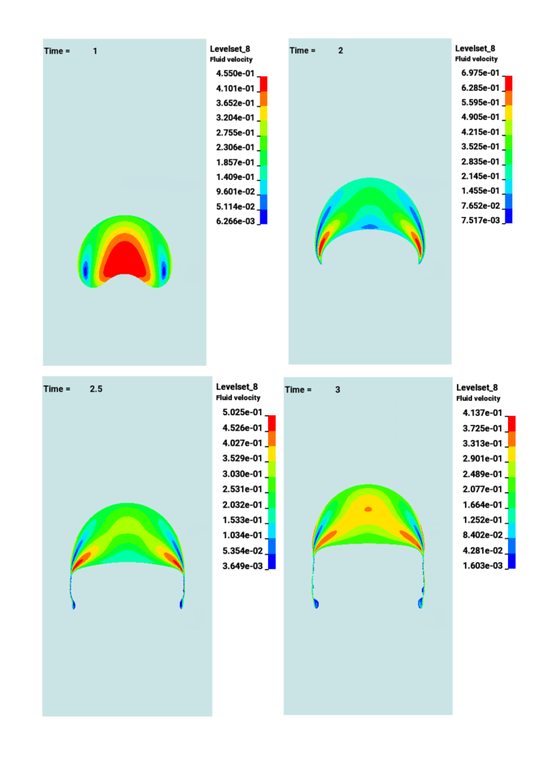*TITLE
*KEYWORD
*DATABASE_BINARY_D3PLOT
*DEFINE_CURVE_TITLE
*ICFD_BOUNDARY_FREESLIP
*ICFD_BOUNDARY_NONSLIP
*ICFD_CONTROL_ADVECTION
*ICFD_CONTROL_LEVELSET
*ICFD_CONTROL_TIME
*ICFD_INITIAL_LEVELSET
*ICFD_MAT
*ICFD_PART
*ICFD_PART_VOL
*ICFD_SECTION
*INCLUDE
*LOAD_BODY_Y
*MESH_SURFACE_ELEMENT
*MESH_SURFACE_NODE
*MESH_VOLUME
*PARAMETER
*END
*KEYWORD
$ Example provided by Zlatko (Ansys)
*TITLE
$# title
ICFD rising bubble Test 1
$ ICFD rising bubble Test 2
*INCLUDE
mesh320.k
$---+----1----+----2----+----3----+----4----+----5----+----6----+----7----+----8
$ $
$ PARAMETERS $
$ $
$---+----1----+----2----+----3----+----4----+----5----+----6----+----7----+----8
*PARAMETER
$# prmr1 val1
R T_end 3.10
R dt_plot 2e-2
R dt_fluid 2.e-4
R cfl_sf 1.0
R dt_init 0.0
R grav 0.98
$ Test 2
$R st 1.96
$ Test 1
R st 24.5
$
R mu1 10
R ro1 1000.
$ Test 2
$R mu2 0.1
$R ro2 1.0
$ Test 1
R mu2 1.0
R ro2 100.0
$ Sphere radius and center
R rad 0.25
R xor 0.5
R yor 0.5
$---+----1----+----2----+----3----+----4----+----5----+----6----+----7----+----8
$ $
$ DATABASE (OUTPUT) $
$ $
$---+----1----+----2----+----3----+----4----+----5----+----6----+----7----+----8
*DATABASE_BINARY_D3PLOT
$# dt
&dt_plot
*ICFD_DATABASE_RESIDUALS
$# rlvl
1
$---+----1----+----2----+----3----+----4----+----5----+----6----+----7----+----8
$ $
$ ICFD BOUNDARY/INITIAL CONDITIONS $
$ $
$---+----1----+----2----+----3----+----4----+----5----+----6----+----7----+----8
*ICFD_BOUNDARY_FREESLIP
1
*ICFD_BOUNDARY_NONSLIP
2
*ICFD_BOUNDARY_FREESLIP
3
*ICFD_BOUNDARY_NONSLIP
4
*LOAD_BODY_Y
1 1
*DEFINE_CURVE
1 &grav
0.0 1.0
10000.0 1.0
$---+----1----+----2----+----3----+----4----+----5----+----6----+----7----+----8
$ $
$ ICFD CONTROL CARDS $
$ $
$---+----1----+----2----+----3----+----4----+----5----+----6----+----7----+----8
*ICFD_CONTROL_TIME
$# ttm dt
&t_end &dt_fluid &cfl_sf &dt_init
,1
*ICFD_CONTROL_MESH
,,,1,
*ICFD_CONTROL_LEVELSET
$# plset dg timeint
20 1 2
1
*ICFD_CONTROL_ADVECTION
1
$---+----1----+----2----+----3----+----4----+----5----+----6----+----7----+----8
$ $
$ ICFD PARTS/ SECTION/ MATERIAL $
$ $
$---+----1----+----2----+----3----+----4----+----5----+----6----+----7----+----8
*ICFD_MAT
$# mid flg ro vis st
1 1 &ro1 &mu1 &st
*ICFD_MAT
$# mid flg ro vis st
2 1 &ro2 &mu2 &st
*ICFD_SECTION
$# sid
1
*ICFD_PART_TITLE
left
$# pid secid mid
1 1 2
*ICFD_PART_TITLE
top
$# pid secid mid
2 1 1
*ICFD_PART_TITLE
right
$# pid secid mid
3 1 1
*ICFD_PART_TITLE
bottom
$# pid secid mid
4 1 1
*ICFD_PART_VOL
$# pid secid mid
5 1 1
$# spid1 spid2 spid3
1 2 3 4
$---+----1----+----2----+----3----+----4----+----5----+----6----+----7----+----8
$ $
$ ICFD MESH KEYWORDS $
$ $
$---+----1----+----2----+----3----+----4----+----5----+----6----+----7----+----8
*MESH_VOLUME
$# volid
10
$# spid1 spid2 spid3
1 2 3 4
*ICFD_INITIAL_LEVELSET
3 &rad 0.0 0.0 &xor &yor 0.0 1
*END

This famous benchmark problem consists of a spherical bubble placed in a liquid. Gravity, hydrostatic force and surface tension act on it and its lower density compared to the surrounding medium causes it to rise. Two sets of parameters are studied (Test 1 and Test 2) and the objective of this benchmark is to evaluate the different numerical algorithms by studying quantities likes center of mass evolution and circularity. The results shown in the video has been achieved thanks to some developments introduced in LS-DYNA R15. The levelset advection uses a semi Lagrangian approach. The levelset re-initialization uses a closest Point algorithm and the Laplace-Beltrami approach is used to handle the surface tension effects at the interface between the two fluids.
Reference : S. Hysing, S. Turek, D. Kuzmin, N. Parolini, E. Burman, S. Ganesan, and L.Tobiska. Quantitative benchmark computations of two-dimensional bubble dynamics. International Journal for Numerical Methods in Fluids, 60(11):1259–1288, 2009.

